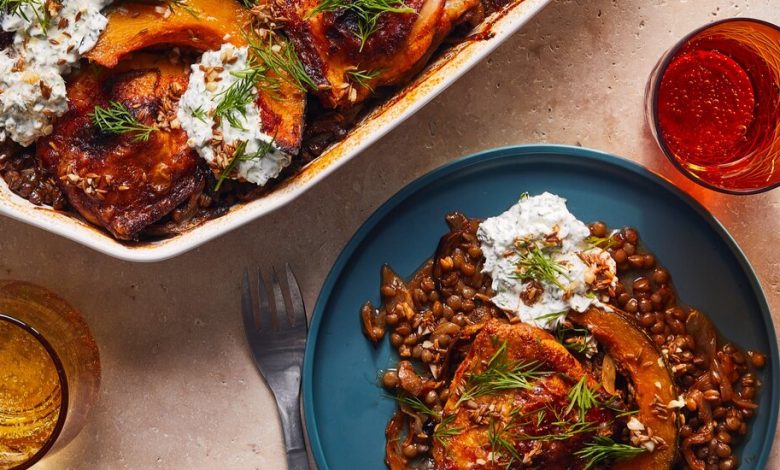Yotam Ottolenghi’s Secret to Great Sheet-Pan Chicken

Like so many people, I love what we call in England a tray bake (Americans might know it as a one-pan dinner). I love how easy it is: ingredients on tray, tray in oven, leave there to cook. I love how few dishes there are to wash and how much the flavor of everything benefits from the exchange of one ingredient with another. I love that my kids love a tray bake: empowered, through choosing for themselves what they’re going to reach for, to be somehow more experimental and relaxed than they might be otherwise.
Behind every apparently relaxed tray bake, though, there’s a method, or certainly a key factor at play, and that is texture. Thinking about the vital role that texture plays in cooking generally — and in tray bakes in particular — can be useful for when the next tray bake is being thrown together from what is in the fridge. It’s also a useful reminder of why you’ll never find a recipe for tray-bake hummus. Or soup. Texture is all.
Recipe: One-Pan Paprika Chicken With Lentils, Squash and Daqa
Take the key players in the one-pan paprika chicken. There are lentils, chicken, kabocha squash and sour cream in the dish. Legumes, protein, squash and dairy: it’s a combination I play with a lot, but the choice of what particular component and which variety I use is key to the success of the dish.
Starting with the chicken, the choice to use thighs, with the skin left on, does lots of useful (and delicious) things. First off, it provides a layer of fat that renders when cooked. As well as making the meat more succulent, the skin also browns and goes crispy, which adds a great textural contrast. But the best thing about starting with brown thigh meat — rich in connective tissues and fibers, which break down and release their collagen once cooked — is that it is so low-maintenance. Unlike a chicken breast, which needs much more careful attention to be cooked without drying out, thighs really can be left alone for the meat to become effortlessly, melt-in-the-mouth soft. You can be delightfully hands-off — lazy, even — if you start with thighs.
The difference between one type of lentil and another is about their respective sizes and shapes and the way these affect their texture. Although I could have used a wider, flatter variety of lentil (a split red lentil, for example, which would collapse, or a brown or green lentil, which would soften quickly), the choice for a smaller, rounder, firmer French Puy lentil, with its much finer texture, was deliberate. At the same time as absorbing the flavor of the stock and spices they’re steeped in, they’ll still keep and hold their shape when cooked. The result is wonderfully unmushy.
Similar story with the kabocha squash. This could have been butternut, or one of the many other types of winter squash available, but it is the texturally firm nature (and nutty flavor) of the kabocha that make this such a winner in a tray bake. Like the lentils, it manages to take on the flavor of what it is being cooked with but still holds its own and keeps its shape both in the tray and on the plate. This doesn’t mean that using something else is wrong — vegetables like sweet potato or celery root work really well — but thinking about the texture as much as the flavor or color will really help with the tray-bake equation.
Sour cream is another deliberate choice, all to do with texture. Sour cream is normal cream that has been given a sharp, sour edge by the addition of a bacteria culture. I could have gone for a looser yogurt or a firmer crème fraîche, each adding a creamy-lemony edge, or even a firmer-still labneh, which is yogurt that has been strained of its liquid. The difference between them all is largely one of texture, which moves along the spectrum from loose and light to firm and dense. None of them are more right than the next; they just give different results.
So, there we go. What might seem rather obvious when looking at a tasty tray bake from a bird’s-eye view is actually a series of key textural qualities. In addition to making us think about the flavors we want to combine, about what the season is outside and what the mood is inside, texture plays a crucial role in allowing ingredients to mix and combine and still remain deliciously distinct.
